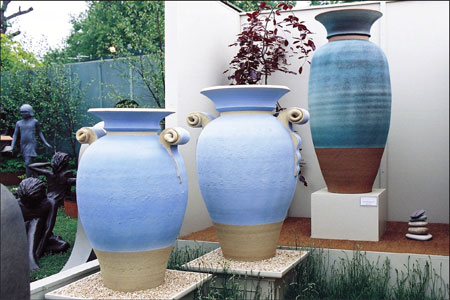
Gardens Under Which Rivers Flow
Issue 1 Sept / Oct 2003
Are you tired of being greeted by overgrown weeds and a patchy lawn as you look out into your garden? Why not try something completely different. Sarah Chick explains how even the least green-fingered emel reader can create a splendid Islamic Garden.
Highgrove House, the official residence of HRH The Prince of Wales, is now home to the maturing ‘Carpet Garden.’ The garden was commissioned by the Prince and made its debut at the Chelsea Flower Show in 1991 where it was awarded a Silver medal.
Many people have Islamic style carpets in their homes, as the rich canvas of colour brightens up any room. Historically, it was not unusual for the wealthy and influential in the Islamic world to commission carpets that reflected gardens, so during the long winter months the beauty of nature could be brought inside and enjoyed. HRH The Prince of Wales is an avid admirer of Islamic art and culture, and was so inspired by the colours and patterns of two Turkish rugs at his home in Highgrove, that he decided to contribute a garden to The Chelsea Flower Show based on this theme. Named the Carpet Garden HRH explained the thinking behind it: “After gazing for many years at the patterns and colours of one of the small Turkish carpets in my room at Highgrove, I couldn't help feeling what fun it would be to use those patterns and colours to create a theme for a garden. The challenge would be to see if you could almost create the effect of being within the carpet.”
The garden was designed by ten times Chelsea exhibitor Michael Miller, together with Dr. Khaled Azzam, Emma Clark and alumni of the Visual Islamic and Traditional Arts Programme at the Prince's Foundation. Miller has achieved considerable success at Chelsea, winning five gold medals in the past. He said: "Of all the gardens which I have created for Chelsea over the years, this has been one of the most technically demanding yet fascinating, trying as we have to incorporate as many important elements of Islamic design and garden tradition as possible."
The garden makes heavy reference to Islamic design and carries many of the features of early Islamic gardens typically found in Spain, such as irrigation channels and covered beds. In addition, there is a central octagonal platform decorated with tile mosaic supporting a circular fountain bowl (a single piece of white marble weighing on and a quarter tons).
The bowl was constructed in Granada by Ms Jana Perez who is one of the world's leading experts in tile mosaic. The Prince, who monitored every stage of the design of his dream garden, even visited the Porcelanosa factory in Spain that manufactured the decorative tiles for the garden's central mosaic. There were 56 different shaped tiles used in the fountain area alone. “Water is essential in an Islamic garden, not only for its life-giving properties but also because it purifies both body and soul,” according to Emma Clark. The central fountain is based on the number eight, a number associated with Paradise in Islam.
Four elements are expressed with water (the fountain), shade (trees), colour, and perfume (flowers), echoing the Qur’anic descriptions of Paradise, the final abode to which Muslims aspire. “The garden encapsulates many of the elements essential to the traditional Islamic garden,” explains Clark. A central octagonal platform, decorated with tile mosaic, supports a circular fountain bowl. The circumference of the fountain's central bowl is divided into 64 sections to continue the principle of the octagon. The whole structure, weighing some nine tons, was shipped in sections from Granada to Chelsea and re-erected at the Show.
Two sides of the garden are walled while the other two offer visitors various aspects of the carpet effects. Pathways split the garden into four quarters, and pit beds have been included for irrigation. These are the typical ingredients of ancient gardens of the Middle East and Islamic Spain, combining practicality with astounding aesthetic appeal.
The plants used in the garden replicate the colours of the carpets. Many have been selected from a list of those found in early Islamic gardens, for example Delphiniums. Others are more modern but have been specifically chosen for their colours, for example, Purple Berberis. Densely planted red and pink Roses, sunk into pits to reveal the head of the blooms, line the rills' edges. Citrus fruit trees are planted between them.
The remainder of the perimeter beds are planted with a mixture of blue, terracotta, white and maroon plants.
If you would like to see the Carpet Garden at Highgrove House, apply in writing to:
The Prince of Wales Office
St James' Palace
London SW1A 1AA
Over 100,000 people visit there each year.
words: Sarah Chick
images: Jerry Harpur & Taous Makhatcheva
Bookmark this |
|
Add to DIGG |
|
Add to del.icio.us |
|
Stumble this |
|
Share on Facebook |
|
Share this |
|
Send to a Friend |
|
Link to this |
|
Printer Friendly |
|
Print in plain text |
|


Comments
0 Comments